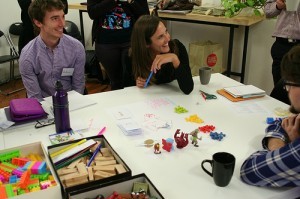I recently had the pleasure of participating in a Liberating Structures workshop in Vancouver. Liberating structures can be defined as “microstructures that make it quick and simple for groups of people of any size to radically improve how they interact and work together” (Lipmanowicz & McCandless, 2013, p. 21). At the core of Liberating Structures’ philosophy is the idea that small and simple shifts in our routine interactions can make it possible for everyone to be included and engaged.
During the 2 1/2 day workshop, I tried out a variety of approaches that I can use in my facilitation, teaching, small group interactions, and individual activities. Several of the approaches were new, while others I had encountered before –usually, in a slightly different way than they were presented at the immersion workshop (see here for full description of all the miscrostructures).
I have been thinking about what made some of the microstructures feel more purposeful at the immersion workshop as compared to in other settings where I have used and/or encountered them (or variations of). I’ll use 1-2-4-all as an example because of it’s likeness to think-pair-share as I think about the differences and similarities:
- The invitation: During the LS workshop, participants were encouraged to pay close attention to the invitation (one of the 5 design elements in all the microstructures). Though the invitation in think-pair-share is just as important as in 1-2-4 all, I have tended to create the wording ‘on the fly’. I have typically used “Reflect on…”, “On your own, think about…”. Now I am paying more attention to how I choose my words for even a ‘simple’ activity and writing these out before hand.
- Purpose: The invitation (and all other design elements) are closely linked to purpose. The importance of purpose has always been top of mind, and the point was made over and over during the workshop.
- Sharing in foursomes: In think-pair-share, I sometimes ask pairs to join and discuss in fours before we begin to report out in the large group. In 1-2-4-all, the foursome piece is key to the activity because the purpose of this activity is to provide a venue for expressing thoughts, gathering diversity of input and building meaning-making among the group. When doing 1-2-all, and the foursome piece is left out, I think there is less opportunity to achieve the purposes described previously.
- Sharing an important/valuable/worthwhile idea to the large group: What made this step most useful for me was that our facilitator instructed (“invited”) us to consider and come to some agreement (as a foursome) on: “What is one idea that stood out in your conversation?” He also suggested that only those ideas that were important and valuable to the whole group be shared with the whole group. In doing so, he made me think carefully about what I wanted to share and why.
Thank you to Leva Lee and Tracy Kelly from BC Campus‘s Professional Learning, UBC CTLT and others who organized this worthwhile event! See here for two related posts on Liberating Structures by Tracy Kelly.

